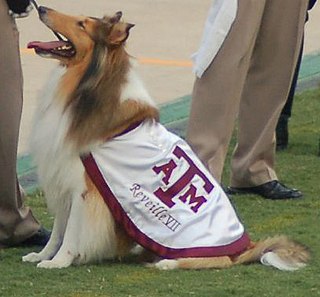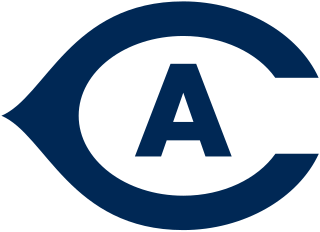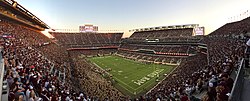Midnight Yell Practice, known locally as Midnight Yell or Yell Practice, is a tradition at Texas A&M University. Midnight Yell is similar to a pep rally. On the night before each home football game, Midnight Yell takes place in Kyle Field at midnight; two nights before each away game, a Yell Practice is held near the Quadrangle on the south side of campus. At midnight on the night before an away game Midnight Yell is held in or near the opponent's city.

Olsen Field at Blue Bell Park is a baseball stadium in College Station, Texas, that is home to the Texas A&M baseball program. The stadium was dedicated on March 21, 1978, and is named in honor of C. E. "Pat" Olsen, a 1923 graduate of Texas A&M University and a former baseball player in the New York Yankees farm system. Olsen Field has served as an NCAA regional site five times and had its 1999 regional attendance ranked second with 53,287. The first NCAA Regional Tournament held at Olsen Field was in 1989.

Reveille is the official mascot of Texas A&M University. Students adopted the first Reveille, a mixed-breed dog, in 1931. The cadets raised $100 during World War II to make Reveille a general, as part of a fundraiser for the K-9 Corps. Reveille is the highest-ranking member of the Texas A&M Corps of Cadets.

Darrell K Royal Memorial Stadium, located in Austin, Texas, on the campus of the University of Texas, has been home to the Longhorns football team since 1924. The stadium has delivered a home field advantage with the team's home record through November 17, 2018 being 375–117–10 (.764). The official stadium seating capacity is 100,119, making the stadium the largest in the Big 12 Conference, the seventh largest stadium in the United States, and the ninth largest stadium in the world.

Tiger Stadium is an outdoor stadium located in Baton Rouge, Louisiana, on the campus of Louisiana State University. It is the home stadium of the LSU Tigers football team. Prior to 1924, LSU played its home games at State Field, which was located on the old LSU campus in Downtown Baton Rouge.

Jones AT&T Stadium is an outdoor athletic stadium on the campus of Texas Tech University in Lubbock, Texas. Built in the style of Spanish Renaissance architecture, it is the home field of the Texas Tech Red Raiders of the Big 12 Conference.

Aggie Memorial Stadium is an outdoor football stadium in the southwestern United States, located on the campus of New Mexico State University in Las Cruces, New Mexico. It is the home field of the New Mexico State Aggies of Conference USA.

Cajun Field is a football stadium located on the South Campus of the University of Louisiana at Lafayette in the city of Lafayette, Louisiana. Nicknamed The Swamp, it is the home field of Louisiana Ragin' Cajuns athletics. Cajun Field is primarily used for its American football team. Cajun Field has an official capacity of 41,426 with 2,577 chairback seats.

Jack Trice Stadium is a stadium located in Ames, Iowa, United States. Primarily used for college football, it is the home field of the Iowa State Cyclones. It is named in honor of Jack Trice, Iowa State's first African American athlete, who died of injuries sustained during a 1923 game against Minnesota. The stadium opened on September 20, 1975, with a 17–12 win over Air Force.

Faurot Field at Memorial Stadium is an outdoor sports stadium in Columbia, Missouri, United States, on the campus of the University of Missouri. It is primarily used for football and serves as the home field for the Missouri Tigers' program. It is the third-largest sports facility by seating capacity in the state of Missouri, behind The Dome at America's Center in St. Louis and Arrowhead Stadium in Kansas City. In 1972, Memorial Stadium's playing surface was named Faurot Field in honor of longtime coach Don Faurot.

The traditions of Texas A&M University are a key aspect of the culture of Texas A&M University. Some of the school traditions date to the 1890s, shortly after the opening of the school, while others have been introduced more recently. These traditions encourage current students and alumni (Aggies) to cultivate the Aggie Spirit, a sense of loyalty and respect for the school, and dictate many aspects of student life, including how to greet others, how to act at an A&M sporting event, and what words a student may use in conversation. The most visible tradition among senior class students and alumni is the wearing of the Aggie Ring, whose design has been relatively unchanged since its introduction in 1894. Not all Aggie traditions are recognized by the university, and some, like Bonfire, have been discontinued for safety reasons. Texas Monthly states that the students' respect for school traditions and values is the university's greatest strength.

Truist Stadium, formerly Aggie Stadium, is a 21,500-seat multi-purpose stadium in Greensboro, North Carolina. It is located at the north end of the North Carolina A&T State University campus.

The Texas A&M Aggies football program represents Texas A&M University in the sport of American football. The Aggies compete in the Football Bowl Subdivision (FBS) of the National Collegiate Athletic Association (NCAA) and the Western Division of the Southeastern Conference (SEC). Texas A&M football claims three national titles and 18 conference titles. The team plays all home games at Kyle Field, a 102,733-person capacity outdoor stadium on the university campus.

The 2006 Texas A&M Aggies football team completed the season with a 10–4 record. The Aggies had a regular season Big 12 record of 5–3.

The campus of Texas A&M University, also known as Aggieland, is situated in College Station, Texas, United States. Texas A&M is centrally located within 200 miles (320 km) of three of the 10 largest cities in the United States and 75% of the Texas and Louisiana populations. Aggieland's major roadway is State Highway 6, and several smaller state highways and Farm to Market Roads connect the area to larger highways such as Interstate 45.
Many terms are unique to, or hold a special meaning connected with, Texas A&M University in College Station, Texas. The university, often called A&M or TAMU, is a public research university and is the flagship institution of the Texas A&M University System. It opened in 1876 as the Agricultural and Mechanical College of Texas, the first public institution of higher education in that state. In 1963, the Texas Legislature renamed the school to Texas A&M University to reflect the institution's expanded roles and academic offerings. The letters "A&M" no longer have any explicit meaning but are retained as a link to the university's past.

The Arkansas–Texas A&M football rivalry is an American college football rivalry between the Arkansas Razorbacks and Texas A&M Aggies, which started in 1903. Between 1992 and 2008, the schools did not play each other when Arkansas left the Southwest Conference to join the Southeastern Conference. The rivalry was renewed as a neutral-site out-of-conference contest in 2009; in 2012 it once again became a conference rivalry when Texas A&M also joined the Southeastern Conference. Arkansas leads the series 42–35–3.

The UC Davis Aggies football team represents the University of California, Davis in NCAA Division I Football Championship Subdivision (FCS). The football program's first season took place in 1915, and has fielded a team each year since with the exception of 1918 during World War I and from 1943 to 1945 during World War II, when the campus, then known as the University Farm, was shut down. The team was known as the Cal Aggies or California Aggies from 1922 to 1958 when UC Davis was called the Northern Branch of the College of Agriculture.

The 2015 Texas A&M Aggies football team represented Texas A&M University in the 2015 NCAA Division I FBS football season. They played their home games at the newly renovated Kyle Field. They were members of the Western Division of the Southeastern Conference. They were led by fourth year head coach Kevin Sumlin. The Aggies finished the regular season 8–5 overall and 4–4 in SEC play. They were invited to the Music City Bowl, where they were defeated by the Louisville Cardinals, 27–21.

Maverik Stadium, also known as Merlin Olsen Field at Maverik Stadium, is an outdoor college football stadium in the Western United States, on the campus of Utah State University in Logan, Utah. The home field of the Utah State Aggies of the Mountain West Conference, it opened 56 years ago in 1968 as "Romney Stadium" and currently has a seating capacity of 25,100. Its field has a traditional north-south alignment, and sits at an elevation of 4,710 feet (1,435 m) above sea level. The playing surface was natural grass through 2003, and is currently AstroTurf GameDay Grass.

























